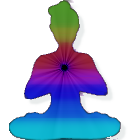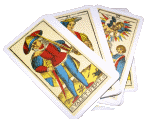In Taoism the ancient symbols for Yin and Yang are the tiger and the dragon, symbolized in this painting by water. The tiger is Yang, dominant, hard, active, aggressive, illuminated, and masculine. The dragon is Yin, soft, yielding, dark, hidden, passive, and feminine. The Tao is the source of Yin and Yang. They are in constant motion, shifting and becoming each other. From this transformation the five Chinese elements are made, and from the five elements, all things are made.
When balance of the elements and the Yin and Yang are achieved it is said that one has the tiger and the dragon. It is the natural symmetry of the Tao, which means the way. Tao is indefinable but it is the first cause of the universe and it is an energy which permeates all.
One of the main tenets of Taoism is wu wei; it means non-action. This should not be thought of as passivity or letting things happen to you, it is better thought of as going with the current. When one sees themselves as connected to everything, rather than being separate, they find that the universe flows in a certain way, like a river, it has a current. To move in harmony with nature, to go with the current, is effortless and you have the power of the whole universe behind you. Alternatively, to struggle against the current and try to go another way will be exhausting and will take much effort with little result. The tiger and the water in this painting are the great strength, unlimited power, and energy one is capable of when moving with the river.
The Yin and Yang represent duality or opposites. Polarity is a good word because it implies the same source. Yin and Yang are sometimes called heaven and earth, mind and body, or spirit and body. To exercise self-restraint and resist going to either extreme of body or spirit is ideal and is called moderation or temperance.
In Tibet monks sit on tiger rugs when they meditate. They are prayer rugs woven with the stylized design of a tiger pelt. The tradition goes back to early Lamas who meditated on real tiger pelts, and myths where holy men flew on the backs of tigers. It is said the tiger is the perfect symbol for the vehicle on the road to enlightenment because it is extremely powerful but may eat you on the way. Today the tiger rugs remind the monk of great physical as well as mental and spiritual strength one must possess to resist negative impulses.
Durga, the Hindu Goddess, rides a tiger because she, like the tiger, possesses unlimited power to battle against mankindís pain and misery and to protect mankindís virtue. She is also immortal as the tiger is said to be. The tiger lives 500 years and then becomes a white tiger and lives another 1,000 years. Then he turns into a piece of amber which lasts through eternity.
The Tyger
In the East the mystical, sacred tiger has permeated the myths, creation stories, and folklore of the people. Mountain Spirit, Spirit of the Forest, they say he embodies the forest spirit in both its awesome power of creation and of destruction. He is a symbol of the symmetry of nature in both beauty and brutality, raw and untamed.
A big inspiration for the Mary-el Temperance card was this poem by William Blake (1757-1827).
The Tyger.
Tyger! Tyger! burning bright
In the forests of the night,
What immortal hand or eye
Could frame thy fearful symmetry?
In what distant deeps or skies
Burnt the fire of thine eyes?
On what wings dare he aspire?
What the hand, dare sieze the fire?
And what shoulder, & what art,
Could twist the sinews of thy heart?
And when thy heart began to beat,
What dread hand? & what dread feet?
What the hammer? what the chain?
In what furnace was thy brain?
What the anvil? what dread grasp
Dare its deadly terrors clasp?
When the stars threw down their spears,
And water'd heaven with their tears,
Did he smile his work to see?
Did he who made the Lamb make thee?
Tyger! Tyger! burning bright
In the forests of the night,
What immortal hand or eye
Dare frame thy fearful symmetry?
To Temper
William Blake envisioned God as a blacksmith pounding out creation with his hammer and anvil. It is an intriguing image in relation to the Temperance card. To temper steel is to harden and strengthen it. The composition of the metal is altered by heating it to very high temperatures and then plunging it into cold water, ice or snow. This makes the carbon content of the steel crystallize.
A person can be tempered, or strengthened, by the application of experience and hardship.
To temper is alchemy, it is the addition of two or more properties, possibly opposing one another, to affect a transformation, growth, evolution, or change. The ideal is to change lead into gold.
An enlightened person is spiritual gold, but it takes careful pounding, heating and cooling, etching and carving on the anvil to make it a thing of beauty, symmetry, strength and compassion.
Keywords for Temperance:
Balance, symmetry, equality, compassion, peace, harmony, equilibrium. Moderation, self control, self restraint, will power, will, resolve. Power, strength, courage, bravery. Mix, measure, mitigate, proportion. Alchemy, chemistry, combine, unite, temper. Mildness, temperate, parallel. To strengthen, harden, or toughen.











